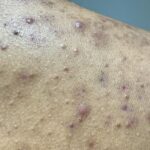 Acne must be the most common presenting complaint for any teenager seeking dermatological advice and it now also seems to be on the rise.
Acne must be the most common presenting complaint for any teenager seeking dermatological advice and it now also seems to be on the rise.
A recent paper in the British Journal of Dermatology looked at trends in the incidence of acne among adolescents and young adults aged 10-24y globally and their findings were interesting.
[Zhu A, Zhong X, Luo Z et al. Global, regional and national burdens of acne vulgaris in adolescents and young adults aged 10-24 years from 1990 to 2021: a trend analysis. Br J Dermatol 2024. doi: 10.1093/bjd/ljae352.]
How was the study carried out?
The data for the study was taken from the Global Burden of Diseases, Injuries, and Risk Factors Study (GBD) 2021.
This is a publicly available study which can be accessed at https://vizhub.healthdata.org/gbd-results/. It provides extensive data on over 350 diseases across over 250 countries from 1990 to 2021.
The authors used this data to look at the prevalence (how many people have acne over a given period of time), the incidence (how many new cases over a period of time) and disability adjusted life years (DALYs) (the number of healthy years lost due to a disease) and then stratified the results according to age groups, sex and sociodemographic index (SDI).
That’s a lot of data!
Yes, they split the age groups into younger adolescents aged 10-14y, older adolescents aged 15-19y and young adults aged 20-24y.
Sociodemographic index was a value depending on level of education, income per head and fertility rate, ie a low SDI value would be because of a low level of education, low income level and high fertility rate.
Worldwide trends were looked at and this was then subdivided into regions eg Southeast Asia, Western Europe etc.
What did they find?
Firstly, they found that the number of cases of acne in adolescents and young adults has increased all over the world by 39.2% from 1990 to 2021, with similar increases in incidence (ie new cases) and with a 40% increase in DALYs.
All age groups showed an increase in incident cases but the largest rise was in the 10-14y age group.
As for specific regions, Western Europe showed the highest age-standardised prevalence but North Africa and the Middle East showed the largest increases in rates of acne between 1990 and 2021.
As for sociodemographic index, those in areas of high SDI had the highest prevalence of acne but those in low SDI areas had the highest increases in rates of acne and the highest DALY rates too.
Why would this be?
We are not sure. The authors postulate that it may be that increased consumption of processed foods, air pollution and higher stress levels may be contributory to the rise in cases.
This could be suggested by the fact that Western Europe has the highest prevalence rates due to consumption of high GI foods, large urban areas with subsequent high levels of air pollution and higher levels of obesity in Western Europe. This would contrast to the situation in North Africa and the Middle East where levels of acne had traditionally been low but are now rapidly increasing. This rapid increase could be due to rapid urbanisation and subsequent lifestyle changes in those areas.
The high prevalence rate in high SDI areas may be because young people in those areas have better access to healthcare and are better at reporting skin problems, combined with the lifestyle factors listed above. However, the rapid increases in rates of acne in low SDI areas could be because of rapid urbanisation and lifestyle changes as aforementioned. The high DALYS in low SDI areas were thought to be due to lack of access to good healthcare, lack of treatment and more severe cases of acne.
So where to from here?
Equitable and accessible healthcare for all is clearly required, no mean feat in certain parts of the world. And also new treatments into the management of acne, beyond antibiotics, hormonal therapies and topical retinoids may also be needed.
However, what is obvious is that our understanding of what drives acne needs to be improved. More research into the effect of environmental and lifestyle factors that can contribute to acne is also required.
Kind regards,
Sandy
Dr Sandy Flann, Consultant Dermatologist.
